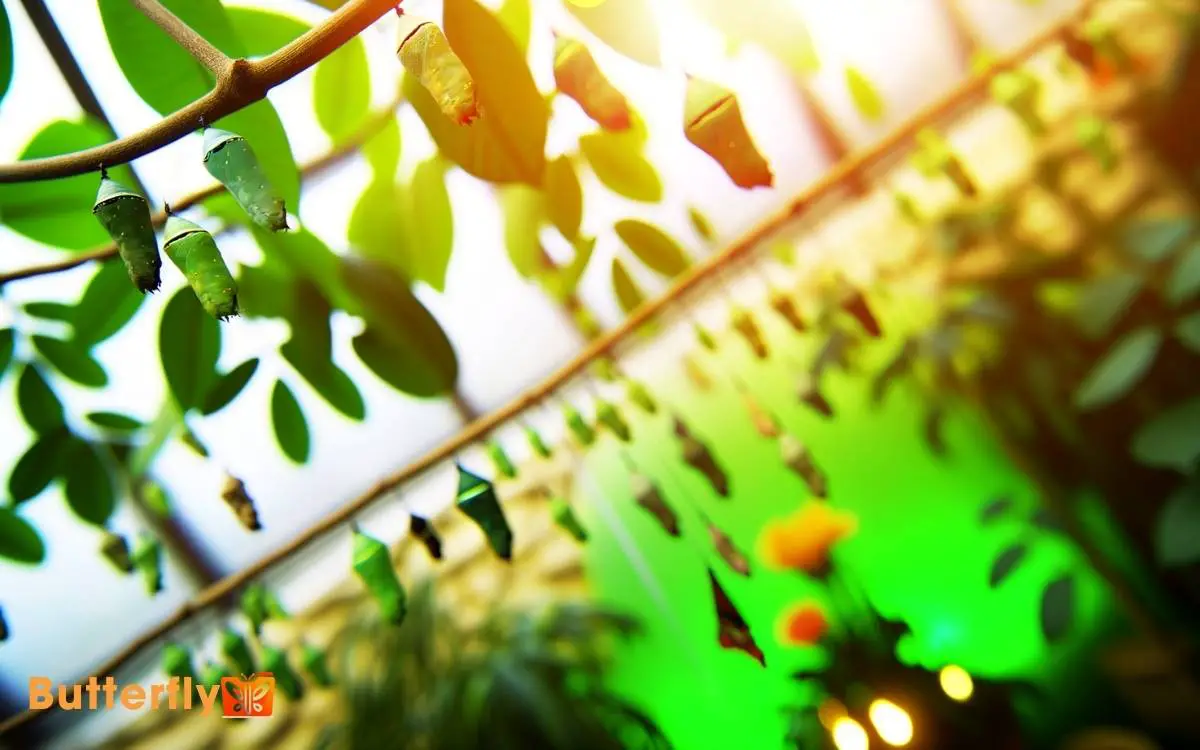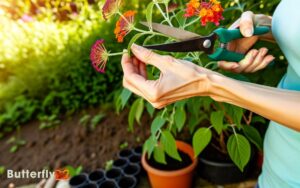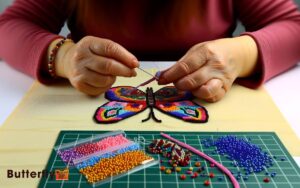How To Raise Butterflies Indoors? Comprehensive Guide!
To raise butterflies indoors, first select a species suited for your environment, like Monarchs. Secure an enclosure that maintains 75-85°F with 60-70% humidity.
Provide fresh, pesticide-free host plants, such as milkweed for Monarchs. Monitor and adjust variables like temperature using grow lights and humidity with misting tools. Source healthy caterpillars or eggs from reputable suppliers.
Offer fresh leaves daily and keep the habitat clean by removing waste and sterilizing weekly. Observe caterpillars for signs of chrysalis formation and maintain ideal conditions.
Soon, you’ll witness the fascinating process of metamorphosis. Continue to perfect your setup and care for rewarding results.

Key Takeaways
Choosing the Right Species
Selecting the appropriate butterfly species for indoor rearing requires careful consideration of their specific habitat needs, life cycle stages, and dietary requirements.
First, evaluate each species’ temperature and humidity preferences to confirm you can replicate their natural environment indoors. Monarchs, for instance, thrive in warm conditions and need milkweed for larval feeding.
Next, understand the duration and conditions of their metamorphosis to prevent any disruptions during pupation.
Lastly, cater to their dietary needs at each stage caterpillars require specific host plants, while adults seek nectar from particular flowers.
Gathering Necessary Supplies
To begin raising butterflies indoors, you’ll need to gather essential supplies. This includes selecting the appropriate butterfly species, acquiring suitable enclosures, and choosing the correct food sources.
Each species has specific requirements for space and nourishment, so it’s important to match your supplies to the needs of the butterflies you plan to raise. Proper preparation guarantees a conducive environment for their growth and development.
Selecting Butterfly Species
When selecting butterfly species to raise indoors, consider the specific environmental conditions and resources each species requires to thrive. Research the native habitat of each species, focusing on temperature, humidity, and light levels.
Monarchs, for example, need milkweed, while Painted Ladies prefer thistle or mallow. Make sure you can provide the correct host plants for caterpillar feeding and nectar sources for adult butterflies.
Investigate each species’ life cycle duration to synchronize their development with your indoor conditions. Also, consider the space requirements, as some species need more room for flight.
Acquiring Proper Enclosures
Before you begin raising butterflies indoors, it’s essential to select enclosures that guarantee adequate ventilation, space, and accessibility for both the caterpillars and adult butterflies. Opt for mesh cages or dedicated butterfly habitats that provide airflow and prevent mold growth.
Make sure the enclosures are spacious enough for the butterflies to spread their wings fully. Accessibility features like zippered openings ease maintenance and feeding.
| Feature | Consideration |
|---|---|
| Ventilation | Mesh sides for airflow |
| Space | Room for wing expansion |
| Accessibility | Zippered openings for easy access |
| Material | Non-toxic, durable materials |
| Visibility | Clear panels for observation |
Each element ensures ideal growth and development, promoting a thriving indoor butterfly environment.
Choosing Food Sources
Selecting the right food sources for your butterflies involves understanding their specific dietary needs at both the caterpillar and adult stages. Caterpillars primarily require host plants, which act as their food source.
Identify the species of your butterflies and research their preferred host plants; for instance, Monarch caterpillars feed exclusively on milkweed.
For adult butterflies, provide nectar-rich flowers like zinnias, lantanas, and coneflowers. You can also supplement their diet with a homemade nectar solution made from sugar and water. Make sure you maintain an organic environment free from pesticides, as chemicals can be fatal.
Setting Up the Habitat
Creating an ideal habitat for raising butterflies indoors involves carefully balancing environmental factors such as temperature, humidity, and light to mimic their natural ecosystem.
To achieve this balance, you’ll need to monitor and adjust these variables meticulously. Aim for a temperature range between 75-85°F and maintain humidity levels at 60-70%.
Use a hygrometer to track humidity and a thermostat for temperature control. Natural light is essential, but you can supplement with full-spectrum grow lights if needed.
| Factor | Ideal Range |
|---|---|
| Temperature | 75-85°F |
| Humidity | 60-70% |
| Light Exposure | Natural/Full-Spectrum |
| Monitoring Tools | Hygrometer, Thermostat |
Ensure your habitat is spacious and well-ventilated to facilitate proper airflow, important for the butterflies’ health and development.
Selecting Host Plants
To successfully raise butterflies indoors, you’ll need to choose host plants that cater specifically to the dietary needs of the caterpillar stage of your butterfly species. Research the natural habitat and food preferences of your chosen species.
Monarch caterpillars, for instance, exclusively eat milkweed, while Black Swallowtails prefer members of the carrot family. Choose plants free from pesticides and contaminants to guarantee a healthy environment.
When selecting host plants, consider the growth stage and nutritional value, opting for young, tender leaves. Provide a sufficient quantity to accommodate voracious appetites and promote continuous growth.
Obtaining Caterpillars or Eggs
One effective way to begin raising butterflies indoors is by sourcing caterpillars or eggs from reputable suppliers who specialize in butterfly rearing. This ensures you’re starting with healthy specimens, essential for successful development. Once you have your caterpillars or eggs, provide them with the appropriate host plant to ensure they have a proper food source as they grow. Carefully monitor their environment, maintaining optimal temperature and humidity levels to support their development into healthy butterflies. If you’re also interested in crafts, you might enjoy learning how to make paper butterflies as a fun and creative complement to your indoor butterfly-raising experience.
When selecting a supplier, consider the following:
- Certifications and Reviews: Verify the supplier’s credibility through certifications and customer feedback.
- Species Availability: Confirm they offer the specific butterfly species you want to raise, as different species have unique requirements.
- Shipping Conditions: Validate they utilize proper shipping methods to maintain the viability of caterpillars or eggs during transit.
Maintaining Proper Temperature
Maintaining the proper temperature is essential for the healthy development of your caterpillars and butterflies, as temperature directly influences their metabolic rates and growth stages.
Aim to keep the environment within the ideal range of 75-85°F (24-29°C). Use a digital thermometer to frequently monitor the temperature.
Inconsistent temperatures can lead to developmental issues or even mortality. If you need to adjust the temperature, consider using a heating pad or a small fan.
| Temperature (°F) | Effect on Development |
|---|---|
| Below 70°F | Slow growth, potential inactivity |
| 75-85°F | Ideal growth and development |
| 86-90°F | Accelerated growth, potential stress |
| Above 90°F | Risk of overheating and death |
Monitoring Humidity Levels
To guarantee the healthy development of your butterflies, you need to maintain a favorable humidity range of 60-80%. Use a hygrometer to measure humidity levels accurately and make adjustments as necessary.
Consistently monitoring these levels will help prevent common issues such as dehydration or mold growth.
Optimal Humidity Range
Monitoring humidity levels is crucial, as butterflies need an ideal range of 60-80% to thrive indoors. Maintaining this range guarantees their delicate wings remain hydrated and functional.
Here are three key points to keep in mind:
- Consistency: Fluctuating humidity can stress butterflies, impacting their growth and lifespan. Use a humidifier to uphold steady levels.
- Ventilation: Ensure proper airflow to prevent mold and mildew, which flourish in high-humidity environments and can harm butterflies.
- Plant Selection: Incorporate humidity-loving plants in your setup; they naturally help regulate moisture levels and create a more stable environment.
Measuring Humidity Accurately
Accurately measuring humidity levels is essential for ensuring that your indoor butterfly habitat remains within the ideal range for their health and wellbeing.
To achieve this, you’ll need a reliable hygrometer. Digital hygrometers are highly recommended due to their precision and ease of use. Place the hygrometer at the center of the habitat for the most accurate readings.
| Humidity Level | Impact on Butterflies |
|---|---|
| < 40% | Dehydration, fragile wings |
| 40%-60% | Best for health |
| 60%-80% | Increased mold risk |
| > 80% | Respiratory issues |
Regularly monitor and adjust the humidity by using techniques such as misting or using a humidifier. Maintaining consistent humidity will foster a stable environment, essential for the butterflies’ metamorphosis and survival.
Feeding the Caterpillars
Guaranteeing caterpillars receive the proper nutrition is crucial for their development, and it begins with selecting the right host plants that cater to their specific species. Analyze the dietary needs of your caterpillars by researching their species-specific requirements.
To maintain a healthy feeding regimen, follow these steps:
- Identify the Host Plant: Determine the primary plant species that your caterpillar naturally feeds on. This guarantees they receive the nutrients essential for growth.
- Regular Fresh Supply: Provide fresh leaves daily. Wilted or moldy leaves can harm their health.
- Monitor Consumption: Keep track of how much the caterpillars are eating. Adjust the quantity as they grow to ensure they’re well-fed without waste.
Cleaning the Habitat
Maintaining a clean habitat for your caterpillars is vital to prevent disease and promote healthy development.
Begin by removing any frass (caterpillar droppings) daily. Use a soft brush or tweezers to guarantee you avoid disturbing the caterpillars. Replace any soiled leaves or paper towels to maintain an ideal environment.
Sterilize the enclosure weekly using a diluted bleach solution (one part bleach to ten parts water), which effectively eliminates pathogens. Rinse thoroughly and allow it to dry completely before reintroducing your caterpillars.
Ensure adequate ventilation to prevent mold and bacterial growth. Employ a fine mesh cover to allow air circulation while keeping contaminants out.
Precision and consistency in cleaning will greatly enhance the health and development of your caterpillars.
Watching for Chrysalis Formation
Observing your caterpillars closely, you’ll notice subtle behavioral changes that signal the onset of chrysalis formation. They’ll begin to consume less food, and their movement will slow.
Watch for these specific indicators:
- Restless Crawling: Caterpillars will wander extensively, searching for a suitable pupation site.
- Silk Production: They’ll start spinning silk mats on surfaces, anchoring themselves securely.
- J-Shape Positioning: Once the silk mat is complete, they’ll hang in a distinctive ‘J’ shape, indicating chrysalis formation is imminent.
Each of these behaviors is a critical precursor to the metamorphosis process. Pay close attention, as the shift from caterpillar to chrysalis is an extraordinary, rapid transformation that provides invaluable insights into the wonders of biological innovation.
Caring for the Chrysalis
To guarantee your chrysalis develops properly, you need to maintain ideal humidity levels, usually between 60-70%. Keep the temperature within a stable range of 70-78°F to facilitate healthy metamorphosis.
Handle the chrysalis gently to avoid any physical damage, which can disrupt the developmental process.
Optimal Humidity Levels
Ensuring that the humidity level remains within the ideal range of 60% and 70% is essential for the healthy development of the chrysalis. This range prevents desiccation and supports the metamorphic process.
To maintain the best humidity conditions, follow these steps:
- Use a hygrometer: Place it near the chrysalis to monitor humidity levels accurately.
- Mist regularly: Lightly mist the enclosure with distilled water if levels drop below 60%. Avoid direct contact with the chrysalis.
- Implement a humidity source: Place a small container of water or a damp sponge in the enclosure to help sustain humidity.
Proper Temperature Range
Maintaining a consistent temperature range between 75°F and 85°F is crucial for the healthy development of the chrysalis. Fluctuations outside this range can disrupt metabolic processes, delaying or even preventing successful metamorphosis.
Use a digital thermometer for precise monitoring. Implementing a thermostatically controlled environment guarantees ideal conditions.
Below is a detailed table outlining ideal temperature settings and their impact:
| Temperature (°F) | Effect on Chrysalis Development | Recommended Action |
|---|---|---|
| Below 75 | Slowed metabolism | Increase heat source |
| 75-80 | Optimal development rate | Maintain consistency |
| 80-85 | Accelerated but safe development | Monitor closely |
| Above 85 | Risk of overheating | Reduce heat source |
Innovation in temperature regulation technology can significantly enhance your success in raising healthy butterflies.
Safe Handling Practices
Handling the chrysalis with care is imperative to avoid physical damage that could hinder its development. You must guarantee that the environment mimics natural conditions to foster healthy metamorphosis.
Here are three essential practices for safe handling:
- Minimal Contact: Only touch the chrysalis when absolutely necessary. Use sterilized tweezers if you need to move it.
- Stable Environment: Keep the chrysalis in a well-ventilated container with consistent humidity and temperature. Avoid sudden changes that could stress the developing butterfly.
- Positioning: Ensure the chrysalis hangs securely. If it detaches, gently reattach it using a small dab of non-toxic glue on its silk pad.
Observing Butterfly Emergence
To observe butterfly emergence, closely monitor the chrysalis for signs of darkening and transparency, indicating that the butterfly is nearly ready to emerge. These changes occur as the wings develop and pigmentation intensifies.
Keep the environment vital optimal temperature ranges between 70-85°F with humidity around 60-70%. Use a magnifying glass to examine the chrysalis; you’ll notice wing patterns becoming visible through the casing.
The chrysalis will split at the top, allowing the butterfly to push out. This process can take several hours, so patience is essential. Make sure the butterfly has space to spread its wings fully.
Document the timing and conditions, fostering innovation by refining your methods for future emergences. This precise observation enhances understanding of metamorphosis.
Releasing the Butterflies
After meticulously observing the butterfly’s emergence, it’s important to guarantee a safe and effective release into its natural habitat.
Follow these steps to make sure the butterflies thrive:
- Timing: Release them during mid-morning when temperatures are warm and birds are less active. This maximizes their chances of survival.
- Location: Choose a spot with plenty of nectar-rich flowers. Avoid areas with heavy traffic or pesticide use to protect their delicate wings and bodies.
- Handling: Gently coax the butterfly onto your hand or a soft surface. Avoid touching their wings to prevent damage to their scales, which are essential for flight.
Conclusion
You’ve now walked the delicate path of metamorphosis, transforming your home into a sanctuary for butterflies. Every step, from selecting the right species to witnessing their emergence, has been a dance of science and wonder.
As you release these fragile creatures into the world, remember, you’ve contributed to the intricate web of life. Your diligent care hasn’t only nurtured butterflies but also enriched the delicate balance of our ecosystem.
Keep observing, learning, and marveling at nature’s miracles.






